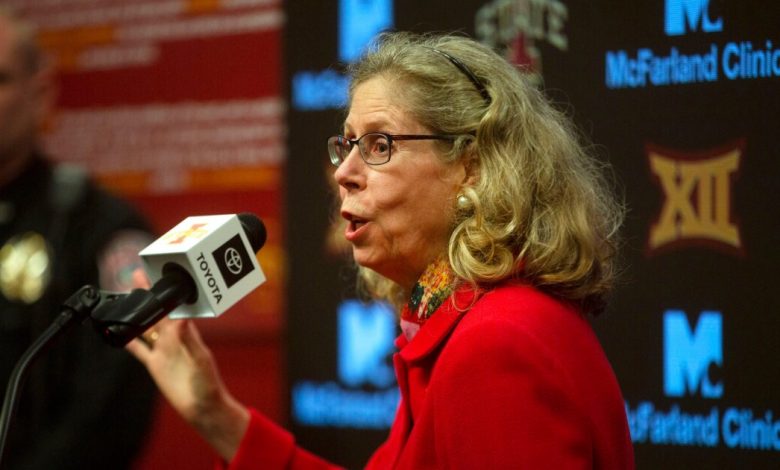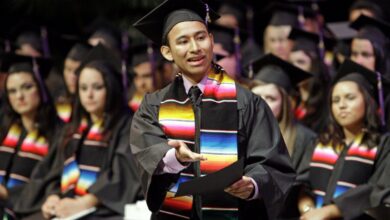Iowa State U. Exits the Coveted AAU

[ad_1]
Iowa State University on Thursday announced that it is leaving the Association of American Universities, the organization long known for conferring a coveted status upon research universities. The decision to exit the association, which institutions join by invitation only, was driven by Iowa State’s sense that its core priorities didn’t match the AAU’s increasing focus on particular types of research, the university said in a statement.
“The decision to end AAU membership is driven by Iowa State’s commitment to its mission, strengths, and impact,” the statement reads. “While the university’s core values have not changed since joining the association in 1958, the indicators used by AAU to rank its members have begun to favor institutions with medical schools and associated medical research funding.” (An Iowa State spokesperson declined to respond to further questions about the decision.)
Pedro Ribeiro, vice president for communications at the AAU, declined to comment on Iowa’s decision in an email to The Chronicle. “Beyond our publicly available membership criteria and policy, AAU does not comment on membership issues,” Ribeiro wrote.
The university’s statement cited statistics on its research expenditures and funding. Iowa State, it said, ranks 16th in federal research spending among U.S. institutions without a medical school, and is among the top 10 percent of institutions receiving funding from the U.S. Departments of Agriculture and Energy, and the National Science Foundation.
Iowa State also articulated a set of institutional prerogatives that went beyond research. “Ultimately, our efforts are measured by the success of our students, the innovation of our faculty, and our service to Iowa and the world,” Wendy Wintersteen, Iowa State’s president, said in the statement. “These metrics are not exclusive to any one institution or group of institutions.”
The university, the statement continued, “remains notable in several important areas not prioritized by the AAU, such as affordability, student engagement, student retention, postgraduation employment, first-generation students, and accessibility.” Iowa State’s tuition, it noted, has historically been among the lowest in the AAU.
‘Handwriting on the Wall’
What it takes to get into — and maintain membership in — the AAU has long been a point of confusion, and controversy, among scholars. Its ranking system, some say, does more harm than good; through the association, a “tiny cabal of venerable institutions has done more to shape and, increasingly, harm the cause of higher learning in America than any other group one could name,” New America’s Kevin Carey wrote in a 2014 report critical of the AAU. Carey, now the think tank’s vice president for education policy and knowledge management and director of its education-policy program, proposed in the report that the AAU steer away from its seemingly singular focus on research spending, instead “rewarding institutions that are committed to keeping college accessible, affordable, and focused on student success.”
Invitations to the association are based on a two-stage assessment, the first of which examines an institution’s research prowess. Itself a two-pronged process, that stage takes into account federal research expenditures — particularly when that money was derived through competitive, merit-reviewed processes — as well as professors’ memberships in the National Academies of Sciences, Engineering, and Medicine and other faculty awards, fellowships, memberships, and citations. The second phase, the AAU’s membership policy says, involves “a more qualitative set of judgments about institutions and their trajectories.”
Carey’s report came three years after a pair of high-profile exits from the AAU. In 2011, the University of Nebraska at Lincoln was ousted by a vote of its fellow member institutions, while Syracuse University withdrew voluntarily after being placed under review, opting not to undergo a vote like Nebraska’s. Leaders of both institutions at the time cited the association’s emphasis on medical research as a factor in their departures.
Nancy Cantor, then chancellor of Syracuse, criticized the AAU’s membership criteria as “narrow,” saying that it relied on data that favored federal research dollars in medicine and the sciences over other factors that come into play at a research university. “I respect what they’re doing,” she said in 2011, “but it doesn’t mean that it covers the landscape for what research universities need to be doing to be critical this century.”
A membership committee at the AAU “periodically evaluates” member institutions, as well as potential candidates for membership. “Nonmember universities whose research and education profile exceeds that of a number of current members may be invited to join the association,” the membership policy says, while “current members whose research and education profile falls significantly below that of other current members or below the criteria for admission of new members will be subject to further review and possible discontinuation of membership.”
David A.M. Peterson, a professor of political science at Iowa State, tweeted on Thursday that the decision to leave the AAU was “really jaw-dropping and an admission that ISU is not on the same tier as the leading universities in North America.”
When Syracuse and Nebraska left the AAU, Peterson told The Chronicle, Iowa State administrators grew concerned that their own membership could be at risk. That led to what Peterson called a “concerted effort to emphasize the kinds of awards and the criteria that the AAU used.” He and other faculty members were sent a spreadsheet of awards that counted toward AAU membership to consider applying for.
But he perceived that Iowa State’s commitment to membership started to wane. Wintersteen, who became president in 2017, hasn’t publicly mentioned AAU status in the same way as her predecessor, Steven Leath, did, Peterson said. And when Wintersteen gave prepared remarks to Iowa State’s Faculty Senate on Tuesday, there was no mention of the AAU decision.
Planned cuts in the College of Liberal Arts and Sciences — which entered the 2022 fiscal year with an $11.4 million annual budget deficit that’s expected to grow to $15 million by the 2025 fiscal year, may also have contributed to Iowa State’s withdrawal. “It does seem like this decision may be motivated by reading the handwriting on the wall” that such cuts could endanger the institution’s AAU membership, Peterson said.
While departures from the AAU have generated controversy, membership has expanded in recent years, too. Dartmouth College, the University of California at Santa Cruz, and the University of Utah all joined in 2019.
[ad_2]
Source link






